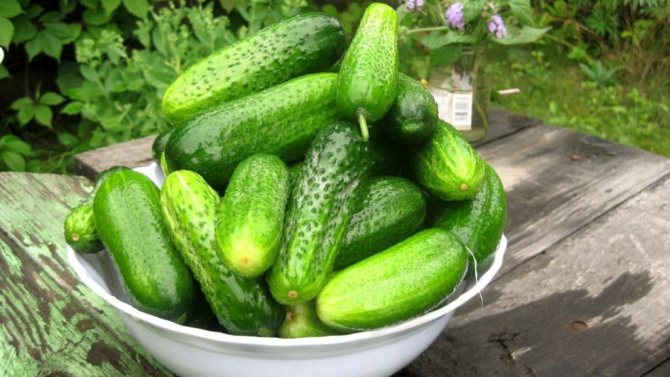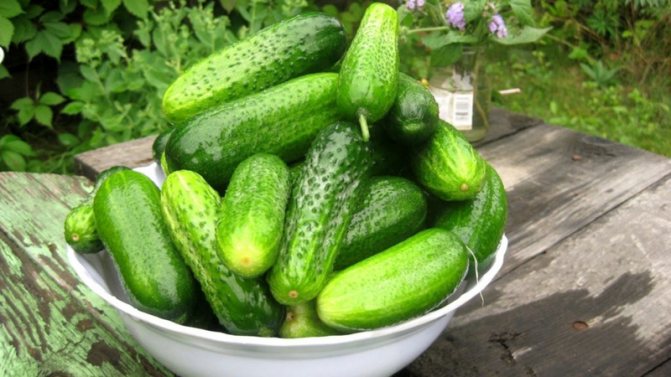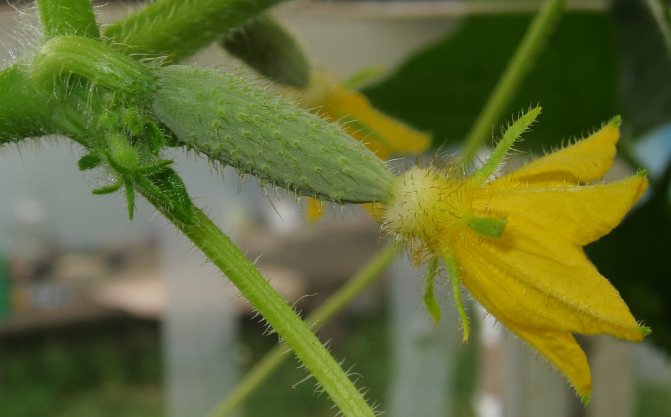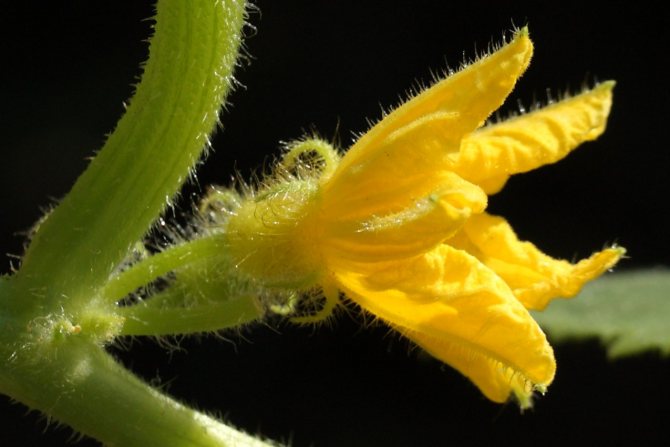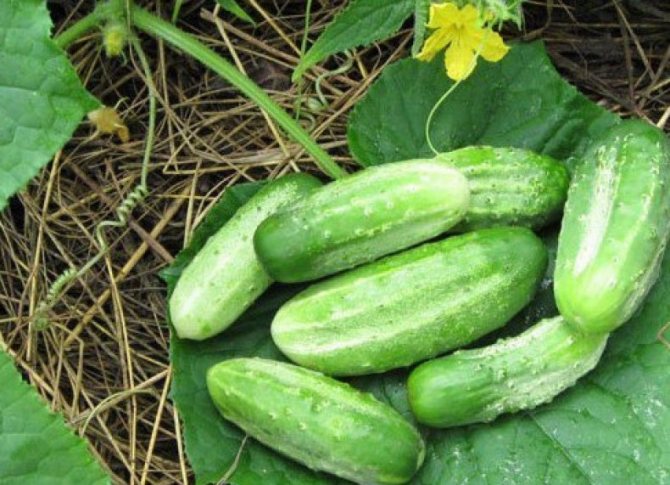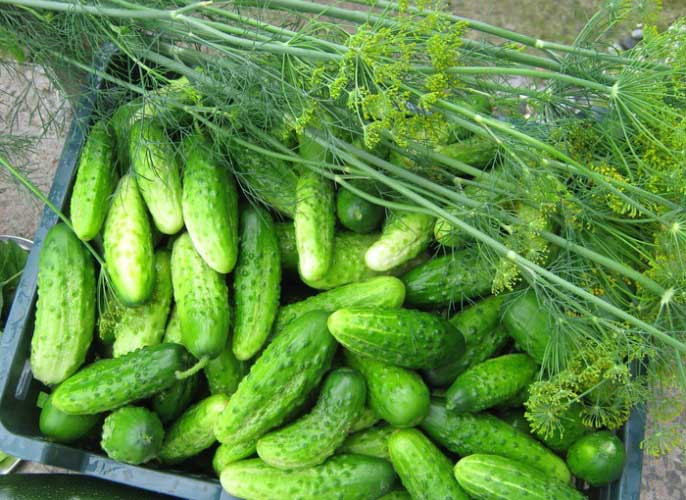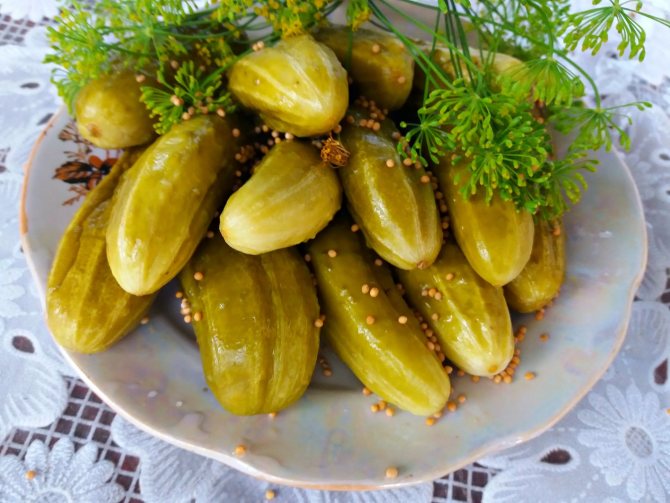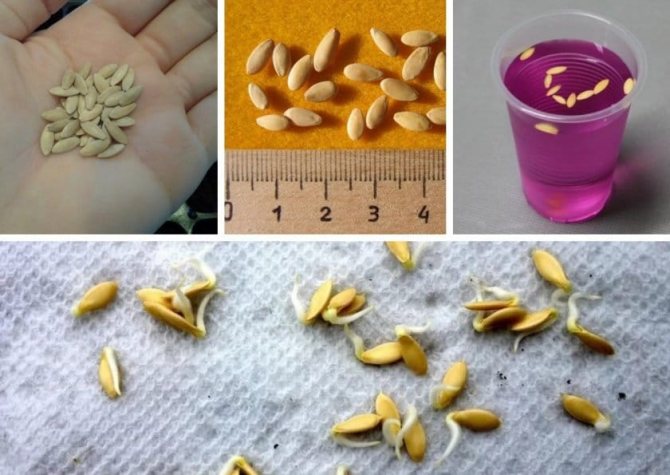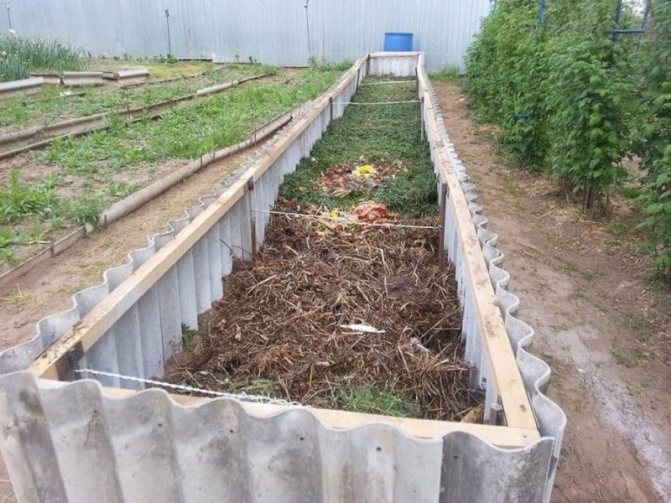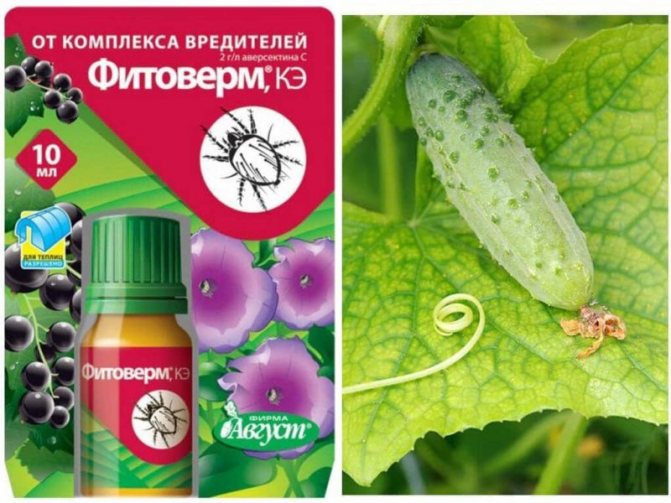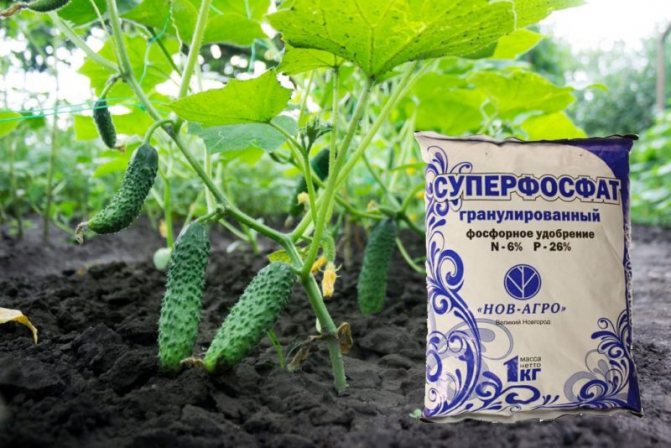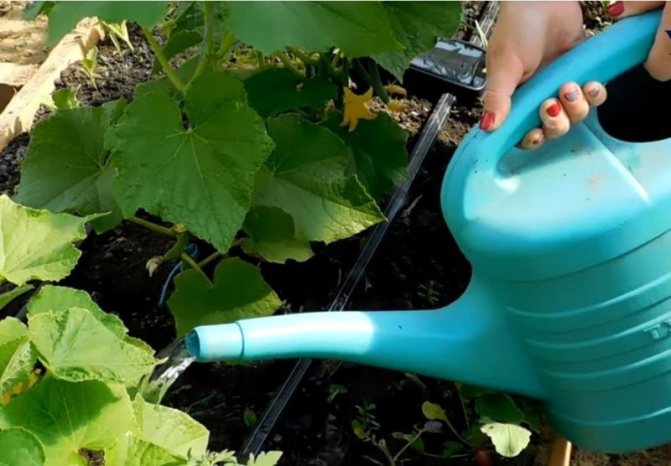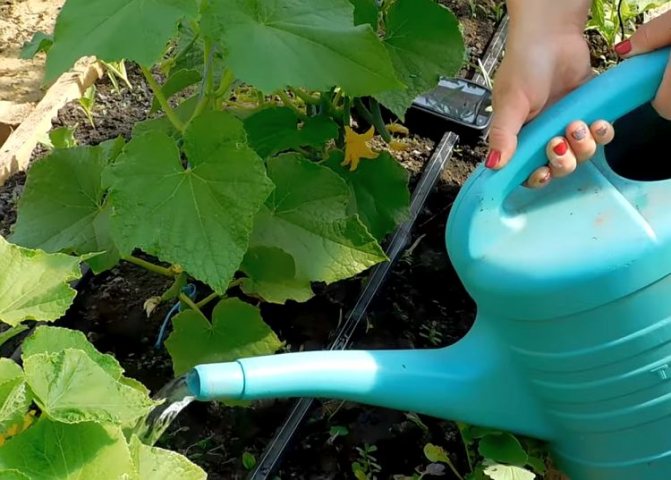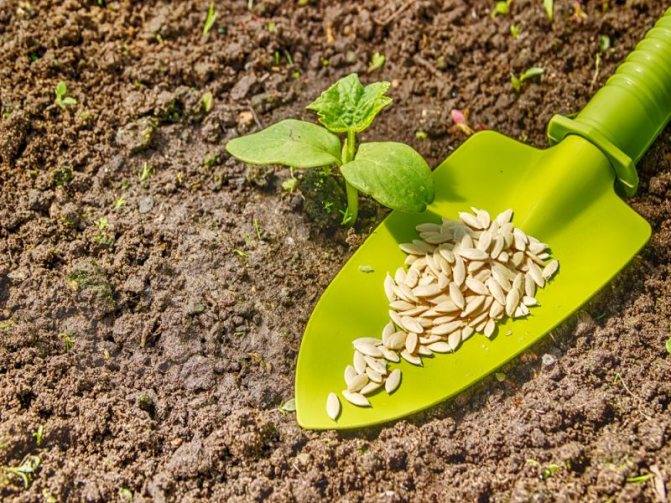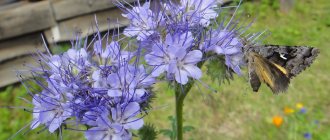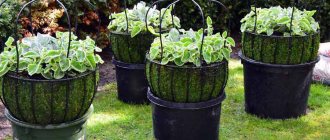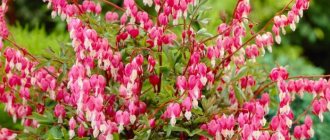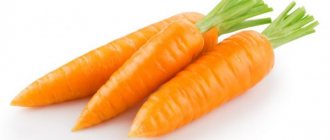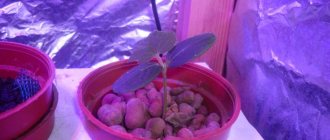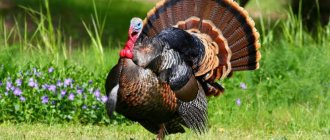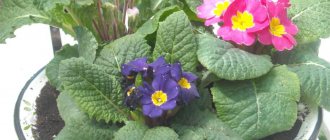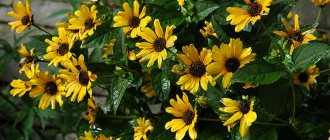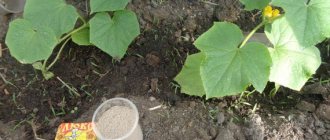Description of the variety Nezhinsky
Medium late variety, Ukrainian selection. From the emergence of seedlings to the harvest of the first harvest, an average of 47-67 days should pass. With temporary shelter, cucumbers will develop quickly, especially if the weather is warm, so the harvest can be harvested early. If the weather is cool and there is no shelter, then the development of the bushes will slow down. Scourges can grow up to 2 meters long. Many ovaries can form in one sinus. The leaves of the plant are simple, bright green, rather large. The flowers are predominantly female.

The skin is bright green, the flesh is crispy, juicy, the seeds are small
Interesting!
Cucumber Nezhinsky can grow well in open ground or under a temporary shelter (greenhouse).
Cucumbers weighing 90-100 g and 10-12 cm long. The shape is simple, oblong. The tubercles are large. The taste of Zelentsov is excellent, sweetish. The skin is bright green. The pulp is crispy, juicy with a cucumber aroma. The seeds are small. The taste is delicate and pleasant.
Characteristics of the Nezhinsky cucumber
Check out these articles as well
- Diseases of sheep
- Apricot Shalah
- Oryol trotter
- Turkish carnation
The positive and negative sides of the Nezhinsky cucumber variety are presented in its characteristics.
- The variety cannot pollinate itself, so pollination by bees is required. This is one of the reasons why these cucumbers cannot be grown in a closed greenhouse.
- Fruiting is extended.
- Productivity is high in the Nezhinsky cucumber variety. From a square of plantings, 1.5 kg of ripe zelents are collected per season!


The Nezhinsky variety cannot pollinate itself, therefore pollination by bees is required
- Immunity to most diseases is average, but if you take proper care of cucumbers, the risk of disease will be reduced to a minimum.
- There is resistance to lack of water, however, if the drought is prolonged, the greens will start to taste bitter.
- The taste is simple but pleasant. A variety of universal use.
- The crop is suitable for long-term transportation.
- The commercial qualities are high. Cucumber Nezhinsky has a neat appearance, the greens are small, even, with a bright color.
It is also important to add that cucumbers of the Nezhinsky variety are undemanding to care. They produce large yields if standard agricultural procedures are followed.
Diseases and their prevention
Cucumbers of the Nezhinsky variety are highly resistant to fungal diseases. But it is still easier to prevent plant infection than to fight to preserve the crop later.
An important point of protection will be the garter of the whips and the removal of the lower leaves. These measures are necessary in order to avoid contact of leaves with the soil, which can lead to fungal infection of cucumbers.
Powdery mildew, a common disease of many plants, can be eliminated in the following way. When the first signs of the disease appear, spray the plant with a solution of 1 liter of mullein and 20 grams of urea (the proportion is indicated for 10 liters).
The next most popular plant disease is the defeat of aphids. From these tiny, but dangerous for the leaves, pests will help the folk recipe from the infusion of soap with wood ash.
After prolonged rainfall, you can spray the plants with fungicides.
Pest control
In addition to good lighting and ventilation of the beds, you sometimes have to use protective equipment.
To destroy aphids, which suck out the juice from the leaves from below, use a folk recipe - an infusion of soap and wood ash: 2 teaspoons of grated soap are taken for 2 glasses of water. You can make an infusion of chopped onion and garlic - 25 grams in 5 liters of water.
Plants are sprayed with these solutions, and you need to process the underside of the leaves, where the aphid is.
To combat spider mites, use a soap solution with celandine infusion. An infusion of celandine is prepared from 100 grams of dry grass and 1 liter of boiling water, insisted for two days. In the finished infusion, rub 20 g of laundry soap until dissolved.
The soap increases the viscosity of the solution and its adhesion to the leaves of the plant. Processing is carried out several times in a row after each harvest (after 2-3 days).
Pest Control Chemicals, from the simplest to the most potent:
- complexes such as Aktofit or Bitoxibacillin;
- insecticides Confidor, Aktara;
- chemical solutions Aktellik, Karate, Fury and others.
dacha.help
Planting cucumbers
Growing cucumbers of the Nezhinsky variety begins with proper planting in the ground. You can sow seeds in well-heated soil. It is better to do this not earlier than May, but in the northern regions a little later. But in order to get an early harvest, it is worth making a small greenhouse, warm up the earth in it, and then it will be possible to sow seeds earlier.
Important!
In order for the cucumbers to sprout faster, it is advisable to soak and germinate them before sowing.
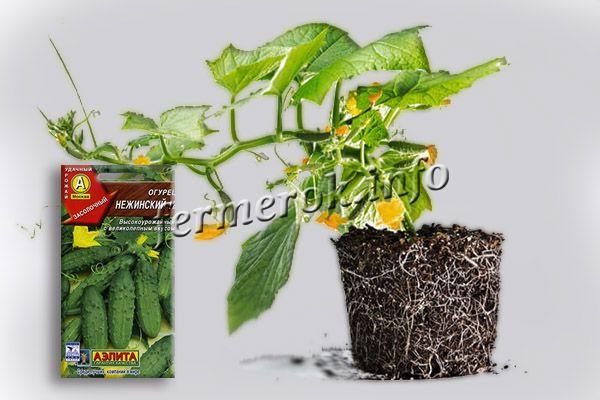

Growing cucumbers of the Nezhinsky variety begins with proper planting in the ground
Before sowing cucumbers, the land must be dug up, loosened. If necessary, fertilizers are applied (humus, wood ash, superphosphate, urea, potassium sulfate). It is necessary to sow seeds according to the scheme 50x30 cm. To do this, the easiest way is to mark the site by making holes for sowing seeds, so it will be much easier not to thicken the plantings. The depth of the holes should be no more than 3.5 cm. After sowing the seeds, it is worth covering them with foil to get early shoots. They remove it after the sprouts hatch.
Soil requirements for planting
To obtain a high yield, it is important prepare the soil correctly and choose a good spot for planting cucumbers. From autumn, it is recommended to bring fresh manure into the ground. Good precursors for cucumbers are tomatoes, potatoes, and cabbage. But after melons and gourds, cucumbers will grow poorly.
In clayey heavy soil, it is difficult for the root system of cucumbers to develop. But this can be corrected by adding humus. Before planting, the soil needs dig up and remove all the weeds.
For loamy soil, manure can be applied one month before sowing the seeds.
Growing seedlings of cucumbers
We recommend reading our other articles
- How and what to feed ducklings from birth
- The best meat breeds of ducks with a description and photo
- Early peach varieties
- Colombo potato variety
In addition, you can grow the Nezhinsky cucumber using a seedling method. In this case, it is necessary to sow seeds for seedlings 1 month before transplanting the shoots to a permanent place. Seeds are sown only in separate containers so that the picking of the grown sprouts is not traumatic. Better to use peat cups or tablets.
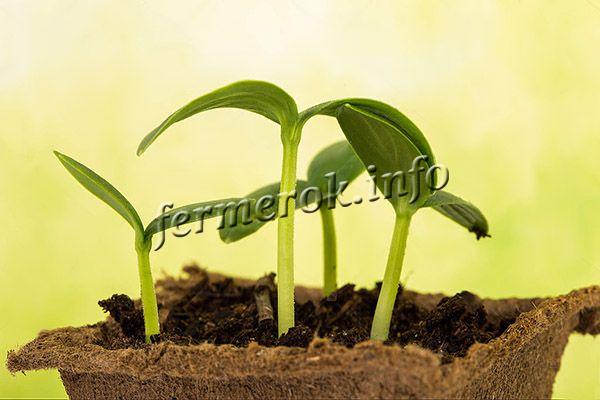

For seedlings, it is better to use peat cups or tablets
To grow strong seedlings of cucumbers, it is necessary to carry out additional lighting. In addition, the room where the seedlings grow should be + 18 ... + 22 degrees Celsius. At night, the temperature can be reduced as desired so that the sprouts do not stretch out. Of course, cucumbers need regular watering, loosening the soil in pots as needed. If the sprouts are weak, you can feed them with complex fertilizers for seedlings.
As soon as a month has passed from the moment of sowing the seeds, the seedlings will be ready for planting in a permanent place. By that time, several strong, healthy leaves should have formed. The sprouts are planted in holes, which are located at a distance of 30-50 cm from each other.
Agrotechnical measures
Cucumber variety "Nezhinsky" is grown in open beds, but if the climate is cold or to protect the planting from recurrent frosts, prepare a film shelter.
You can also plant in greenhouses and greenhouses, but remember that these cucumbers require pollination by insects, so you should not keep buildings closed - bees should fly to the flowers. In addition, growing in greenhouses changes the length of the lashes.
In the beds, they do not have to be cut, and in greenhouses, a long stem is most often pinched at a certain length, when it is not possible to arrange a whip.
Any planting methods are suitable, at the discretion of the owners of the plots:
- seminal;
- seedling.
The first one is used more often. Place the seeds only in warm ground. The most successful time is mid-May, but if the desired temperature (15-20 degrees) has not yet been established, they wait until the end of the month. It is clear that the time may shift depending on the climatic conditions of the area.
Seed material is pre-soaked and prepared for planting. Seed layout on the ground:
- rows at intervals of half a meter;
- holes - after 30 cm;
- burial depth - up to 3 cm.
Agronomists recommend making not furrows for planting cucumbers, but ridges on which supports for the stems are installed. Rules for the construction of ridge hills:
- Trench grooves are prepared with a depth of 30 cm.
- Organic fertilizers are laid: compost, rotten leaves.
- The last stage is the soil in the form of a scallop.
Tip: It is better to plant cucumbers after legumes and members of the nightshade family.
Soil requirements
Nezhinsky needs a fertile and loose soil that can provide oxygen access to the plant's root system.
It is especially difficult to get a good harvest on loam, since this type of soil belongs to the category of heavy, not friable.
In order to cope with this feature, it is necessary to dig in advance the entire area allotted for planting cucumbers, removing weeds, and add rotted manure or humus. It is advisable to complete these works at least a month before the start of sowing seeds in the ground.
If soil preparation is carried out in the fall, then fresh manure can be applied. It is important to remember that the fertility of the soil is influenced by the predecessor plants. Therefore, you should not plant the variety in the beds where melons and gourds grew. The best option is to plant after potatoes, cabbage, or legumes.
Recommendations for the arrangement of beds
Cucumber "Nezhinsky" loves moist soil and bright lighting. A little shading for the bushes is not dangerous, as is drought. However, such deterioration of conditions will reduce yields and shorten the period of fruiting. Alternatively, you can arrange the plants on trellises. The technology will allow you to achieve an excellent harvest. The advantages of trellis supports:
- better air access to plants and fruits;
- excellent ventilation;
- lighting from all sides;
- weaving along the entire length of the stem;
- no entanglement of branches;
- easy bush formation;
- simplification of harvesting.
Another advantage of the technology is the creation of conditions for pollination. The variety blooms with male and female inflorescences. Cross-pollination occurs. On tapestries, this is faster and more efficient.
Growing seedlings
Seeds are sown for seedlings in April - early May. It is important that by the time of transplanting from pots or boxes into open ground, the seedlings are 22-25 days old. This is the optimal age when cucumbers quickly adapt to new conditions, take root and grow.
Important! Potassium permanganate solution is used to disinfect seeds, as well as special preparations.
A good effect is obtained by soaking seeds in various growth stimulants, which contributes to their friendly germination. It is better to sow it immediately in separate containers, so as not to damage the delicate root system of the seedlings during transplantation. During cultivation, the seedlings of cucumbers are fed (you can use Kemir's fertilizer or complex formulations).
Transplanting
The cucumber garden should be in a sunny location. Cucumbers love warmth and light, but Nezhinsky can bear fruit even with a little shade. Since autumn, rotted manure and wood ash are introduced, which can be replaced with complex mineral fertilizers.
When the soil warms up to + 14ºC, you can prepare seedlings for planting in the ground. When grown in a greenhouse, the dates are shifted by a week and a half, where the soil warms up faster.
The planting scheme is three plants per square meter, while it is advisable to immediately install the supports and pull the trellises. In open field conditions, Nezhinsky is often grown in spread, then a garter is not required.
The first days (about 5-6) do not water the bushes. But we must take into account the weather conditions, as well as the condition of the plants themselves. Often, gardeners cover the cucumbers right on the garden bed with non-woven material, which saves young plants from hot rays and possible cold snaps.
sait-pro-
Forming a whip
In the Nezhinsky variety, branching begins late. To speed it up, pinch the top of the main stem over 6–7 leaves. This leads to the active development of lateral lashes, on which many female flowers and ovaries are formed.
You can form bushes on a trellis. This way they are better ventilated and illuminated by the sun. The lashes grow up to 2 meters in length, and it is more convenient to distribute them on the trellis and monitor their development. The garden bed is more compact.
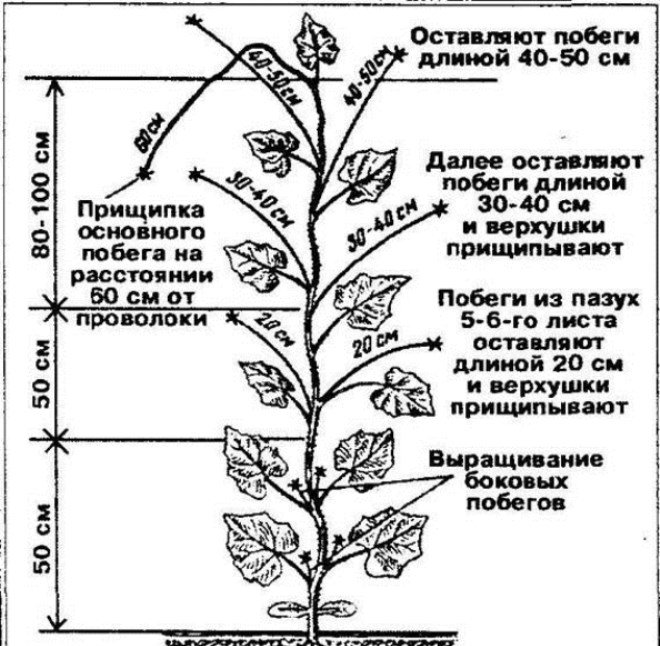

When forming tied plants in a greenhouse or on a trellis, pruning is done as follows:
- Up to 5 leaves, all stepchildren, processes and ovaries are removed ("blind").
- Shoots from the axils of 5-6 leaves are left 20 cm long, the tops are pinched.
- Shoots from the axils of 7–8 leaves are left 30–40 cm long, the tops are pinched.
- Further up, the shoots are pinched, leaving a length of 40-50 cm.
- When the main stem reaches the top bar, it is pinched 3 leaves higher.
Care for the variety Nezhinsky
You can harvest a large harvest of Nezhinsky cucumbers with proper crop care.
- The easiest way to grow a Nezhinsky cucumber is on a trellis. This method of growing allows you to save space on the site and get a rich harvest. In addition, it will be much easier to care for the bushes. As the lashes grow, it is necessary to tie them up if they do not curl, but deviate.
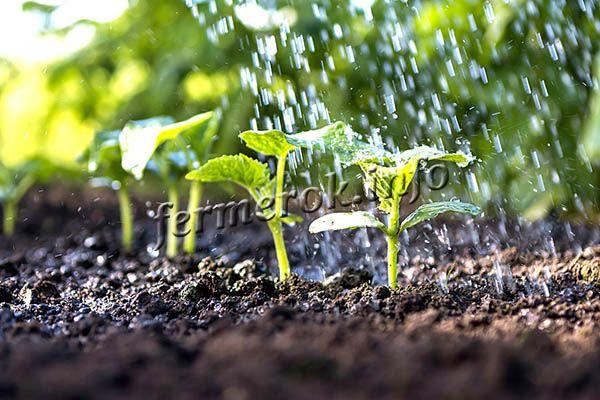

Watering is carried out every 3 days
- Watering is carried out every 3 days, but if the weather is hot, then it is possible every other day. If it rains often, it is necessary to stop watering for a while, otherwise rot may begin to develop.
- Weeding and loosening the bushes are carried out regularly. There should be no weeds on the site, otherwise diseases and pests will appear. To reduce the amount of weeding and weeds, you can mulch the beds. In this case, the weeds will not be able to develop normally, and soil loosening will be carried out only when changing the mulch.
- Fertilizing cucumbers need organic and mineral. Ideally, alternate between them. For foliar feeding, it is better to use a urea solution with the addition of potassium or phosphorus sulfate. For root feeding, wood ash, humus, compost, green infusions are used. From minerals, you can buy a variety of complex fertilizers in liquid, granular or powder form.
Important!
It is necessary to use mineral complex fertilizers for cucumbers strictly according to the instructions, so as not to harm the plants!
- Rationing of the crop is not required, but you can remove the extra leaves so that they do not obscure the cucumbers, otherwise ripening will be delayed.
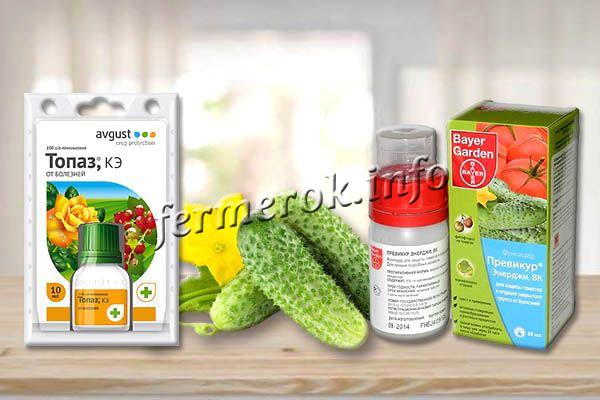

Cucumbers can be treated with fungicides for diseases.
- For diseases, cucumbers can be processed for targeted treatment or for prevention. Fungicides like Topaz, Previkur, Ordan are used in these cases. You can also use tobacco dust, wood ash for pollination, fumigation of bushes with herbs and other folk remedies.
- If pests have appeared on the bushes, you can not hesitate to destroy them. It is necessary to carry out the treatment with "Aktara", "Biotlin" or similar means.
When growing cucumbers of any kind, including Nezhinsky, it is important to remember that they are not planted in one place for two years in a row. It is better to change the place where the cucumbers grow every year. In this case, the yield will be consistently high.
Growing and care
The garden is watered with warm, settled water in the evening or in the morning, when there is no scorching sun. In normal weather, 2-3 times a week is enough, in rainy weather, watering is done less often, in hot weather it is possible every day.
The bushes are formed as needed and tied to supports.
Feed in moderation, but in a balanced way, so that the cucumber gets potassium, phosphorus, nitrogen and magnesium. Irrigation under the root with solutions of manure 1:10 or mineral fertilizers is effective:
- superphosphate;
- potassium and ammonium nitrate;
- potassium sulfate;
- urea;
- ammophoska.
The required fertilizer is taken 20 g per bucket of water.
In the heat, foliar dressing by spraying the foliage is effective. To do this, prepare a solution of urea - 30 g per 10 liters of water.
The soil is carefully loosened, weeds are weeded.
Harvesting and storage of crops
As the harvest ripens, the cucumbers must be harvested. It is advisable to do this as soon as they reach a length of 10-12 cm. Overexposing these cucumbers on pagons is not worth it, as this can lead to overgrowth or spoilage of the taste.


Nizhyn cucumbers are just perfect for pickling and pickling
After harvesting, cucumbers can be stored for 2-3 weeks in the refrigerator without any problems. They will not deteriorate. Cucumber Nezhinsky is suitable for fresh consumption, preparation of various appetizers, summer salads or for pickling, pickling.
Advantages and disadvantages
Cucumbers Nezhinsky have long been known to gardeners for their excellent qualities. Those who have ever grown cucumbers of this variety on their beds note:
- suitability for cultivation both in open beds and in greenhouses;
- the opportunity to receive greens in the fall, when many varieties have already borne fruit;
- the suitability of fruits for cutting into salads, but especially for pickling and canning.
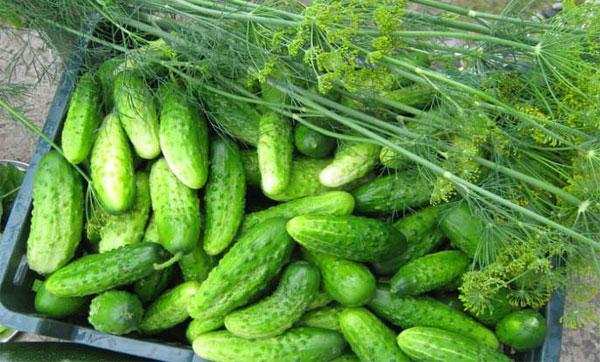

Nizhinsky cucumbers have no significant disadvantages, except that the plants of this bee-pollinated variety, when grown in greenhouses, will need to be artificially pollinated.
Reviews of gardeners about the variety of cucumbers Nezhinsky
Cucumbers of the Nezhinsky variety are known to many gardeners. But if there is no experience in growing cucumbers, then it is better to pay attention when choosing a variety not only to the characteristics and description, but also to the reviews of those who have previously grown these cucumbers. The opinions of gardeners who have already tested the Nezhinsky variety are presented below.
- Petr Nikolaevich: “I plant the Nezhin variety of cucumbers every year. I can grow other varieties in parallel, try new hybrids, but Nezhinsky is the best option for me. Cucumbers are very tasty, juicy, and suitable for curling and for salads. There are no problems in growing, you need to carry out simple procedures, as for other crops. So I recommend everyone to grow these cucumbers for food, although they are good for sale. "
https://youtu.be/OqXmDIf3z8Y - Tatiana Pushkova: “Of the old varieties, I grow only the Nezhinsky cucumber. But lately, it is difficult to find good seeds, so I started ordering them online. I like this variety because greens are suitable not only for fresh food, but also for canning.After pickling, pickling or pickling, they remain crispy, the taste only improves! So for those who use crops for processing, not just salads, this variety will be perfect! ”.
- Marina Stupka: “Usually I grow cucumbers only for food, I like them for their rich taste and aroma. But last year, on the advice of a neighbor, she planted a couple of Nezhinsky cucumber bushes. I was impressed with this variety by its strength of growth, resistance to diseases (many other species were sick besides this). At the end of summer, I did little watering, but the harvest pleased me with its taste, the greens did not taste bitter. I am satisfied with the variety, I will continue to plant it. "
Testimonials
The reviews speak for themselves - over the years of its existence, the Nezhinsky cucumber has shown itself only from the best side.
Galina, Voronezh: “Zelentsy ripens quite quickly and have excellent taste. I collect about two buckets of cucumbers every weekend. Enough for the whole family and for salads and preparations. I sow directly into the ground in mid-April and harvest the fruits until the first frost. "
Victor, Samara: “The Nezhinsky variety was also grown by my parents. I really like its crispy, sweet taste. The yield is high. The variety is unpretentious - regular watering and fertilization in the fall is enough. Recomend for everybody!"
Anna, Krymsk: “I planted Nezhinsky for the first time seven years ago. Since then I have been growing the variety constantly and collecting large harvests. I never let you down. "

